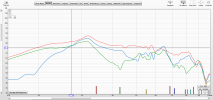Hi i have been going through a few of your posts and looks like you have all sorts of experiments with your setup. Now mine is not that high end, ll soon get the delivery of q3030i fronts, 3090 and 3010 center and rear and 2 atmos ceiling along with bic pl 200ii single sub. Avr is marantz 5015. My question is should i even bother with these kind of tinkering for single sub setup? And what's the most useful and non cumbersome way to optimize this kind of setup without delving into such nitty gritties. Though i can handle the teachnicalities, dont think i ll have the time to do it. Hence asking someone who's already gone through the process of comparing before and after of many combinations.


